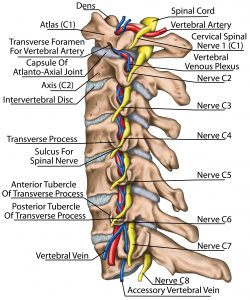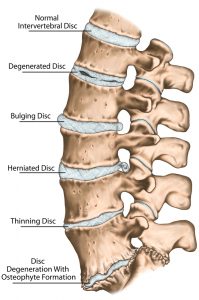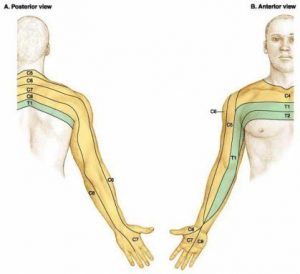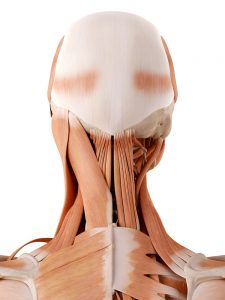10. Neck Injuries
Posted by Phil Heler on December 6, 2015Neck injuries are frequent in sport like tennis (as a player looks up to serve), rugby (in a driving maul or as a scrum collapses), and cycling (after prolonged periods in the saddle).
In many neck injuries, causative movements are so abrupt and unexpected the muscles simply do not have time to be employed so they can help scaffold the ligaments which protect to facet joints in your neck. This exposes structures in your neck to forces that they are not designed to tolerate. Constant persistent loading can also exhaust the same anatomy. Cyclists who spend hours in the saddle may also experience neck stiffness. This often evolves and accumulates with time as you employ your neck muscles in order to see the road ahead over long hours spent in the saddle.
Neck injuries – Joint pain in the neck
Typical symptoms: Local neck pain that can refer to shoulder or shoulder blade. Worsens for looking over your shoulder.
In the spine, facet joints link the vertebrae and are important for preventing excessive rotational and twisting forces which would damage the discs. They also share some of the load bearing of the spine. The correct term for the neck is the cervical spine. The cervical spine has seven vertebra from the first cervical vertebra (or C1) at the top that articulates with the base of the skull through to the seventh (C7) that articulates with the thoracic spine.
When there is a loss of mobility in the spine, the facet joints bear a greater load than normal. This is particularly the case if there is some imbalance in the body and one side of the spine takes more strain than the other. This can occur for all sorts of reasons such as repetitive strain injury resulting from the repetitive movement or mechanical overloading in contact sports.
Once the facet joints are irritated and inflamed people usually experience intense sharp pain for particular neck movements such as rotation and tilting your head back. Pain can be unilateral or bilateral and can sometimes refer into the neck or shoulder. Each joint at different vertebral levels of the neck (cervical spine) will refer to different regions.
Osteopathy can treat this effectively by using gentle techniques to help release the joint concerned and relief muscle tension. Sometimes joint issues can contribute to headaches as well.
Neck injuries – Trapped nerves in the neck
Typical symptoms: Pain will be felt in other areas of the body such as shoulder, arm, elbow and hands. These can be perceived as a constant dull ache, sometimes allied with pins and needles.
Our new IDD Therapy programme is effective in treating trapped nerves, is non-invasive (unlike surgery) and is pain-free. IDD Therapy bridges the gap between what manual therapy cannot achieve and surgery. This therapy is the fastest-growing therapy for trapped nerves and degenerative disc issues in the UK.
The discs at the bottom of your neck (at C4/C5 or C5/C6 or C6/C7) are the levels most likely to suffer from disc bulges or herniations as they help support most of the weight of your head.
Heavy impacts can impose sharp sudden forces to the area. When these discs bulge or herniate they can press on nerves which innervate your shoulder and arm.
These nerves can become trapped for several different reasons and refer to the arm and shoulder. The areas a single nerve innervates in the arm and shoulder is called a dermatome and each specific nerve will be responsible for sensory perception in different areas (temperature, touch, vibration, pressure and pain). Therefore, if a nerve is impinged in the neck, pain and pins and needles (or paraethesia) will refer to any given dermatome.
The most common causes of trapped nerves are herniated and bulging discs, spinal stenosis, facet joint arthropathy and degenerative discs.
Our new IDD Therapy programme is effective in treating trapped nerves, is non-invasive (unlike surgery) and is pain-free. IDD Therapy bridges the gap between what manual therapy cannot achieve and surgery. This therapy is the fastest-growing therapy for trapped nerves and degenerative disc issues in the UK.
Neck injuries – Soft tissue pain in the neck
Typical symptoms: Pain on movement of the neck, upper back pain and tenderness allied with possible headaches and dizziness. Intensity depending on severity of impact.
The purpose of ligaments is to act like rubber bands and restrict excessive movement in the neck in flexion, extension and rotation. Therefore, in the event when the neck is forced beyond its normal range of movement, these are the structures most often injured.
A movement that forces our neck beyond its normal physiological range of movement usually affects the muscles as well that help control and oppose the angle our neck is forced into. Muscle and muscle tendon injuries are also commonplace.
Many sports impose long periods of postural strain on arms, shoulders and neck. This is very true in sports that are unilateral such as racket sports or sports that involve throwing. Although we may be initially unaware of the effects this will lead to an increase in soft tissue tension in the neck and shoulders especially. This is the first stage of symptoms and may last for several weeks or longer.
If nothing is done, the symptoms of RSI are likely to get exacerbate, intensify and last longer. Without treatment, the symptoms of RSI can become constant. At this stage the condition may be irreversible.
An osteopath can help give gentle massage to the tight muscles and manipulation to loosen the joints of the neck, thorax and back can relieve the build-up of muscular tension that may over time lead to headaches.



